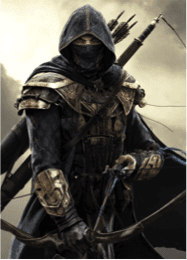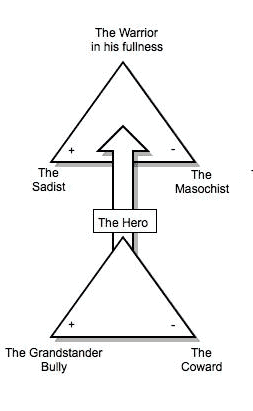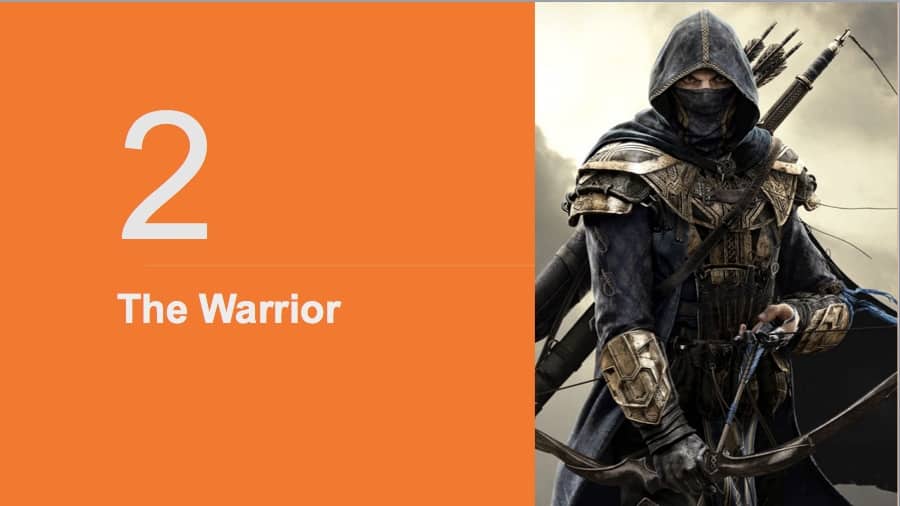The Warrior – is healthy when in service to the ideal
 The Warrior
The Warrior
The warrior is a powerhouse of energy, the source of which is a transpersonal commitment. He is fiercely loyal to his warrior code – which is his honor – and to the king, who, in mythology, represents his purpose. The warrior is not concerned about his own comfort and security in pursuit of his goal, as his training teaches him to live with death as his constant companion. The domain of the Warrior is the battlefield – be it a battlefield of war, of spirituality, or of moral ethics. The Warrior’s purpose is often to destroy, but the mature warrior destroys only that which is negative and harmful to the world. He is a master tactician, knowing at all times his limitations, and finds creative ways around them. The warrior is not a thinker, he is
The Sadist is the active (+) polarity of the Shadow Warrior. The Warrior’s detachment from life leaves the door open to cruelty. The Warrior is most vulnerable in the area of relationships, where he must constantly stay vigilant of his mind and emotions. They must not be repressed, but be under control, lest cruelty sneaks into him while he isn’t looking.
The Masochist is the passive pole of the Shadow Warrior. The Masochist projects Warrior energy onto others and experiences himself as impotent and vulnerable in their presence. He is unable to defend himself psychologically and allows others to manipulate and mess with him. A man might endure enormous amounts of abuse until one day he might snap, and percolate back to the Sadist.

In this presentation, we explore the warrior and its application into our own lives. The light, dark and power of the warrior are expressed by his mission, purpose, and depth of meaning.
The Warrior in His Fullness
Moore says that “The characteristics of the Warrior in his fullness amount to a total way of life, what the samurai called a do (pronounced ‘do’). These characteristics constitute the Warrior Dharma, Ma’at, or Tao, a spiritual or psychological path through life.”
What are these characteristics? Let’s take a look.
Note: While here we use the language of the martial warrior, the characteristics can be applied to any man’s life mission, whether civilian or true solider.
Aggressive
If you look up the word “aggressive” in the dictionary, these are the definitions you’ll find:
1. characterized by or tending toward unprovoked offensives, attacks, invasions, or the like; militantly forward or menacing2. making an all-out effort to win or succeed; competitive3. vigorously energetic, especially in the use of initiative and forcefulness
Of the three definitions, the first is most popular in modern culture. Something unprovoked, out of line. Notice how often “overly” precedes “aggressive” in common parlance. Aggression may also bring to mind military policies a person does not agree with. In general it has a negative connotation.
But true aggression should be thought of in the context of the second two dictionary entries. Effort. Energy. Initiative. Force. Aggression is a neutral tool that can be harnessed for either ill or good. How it is channeled makes all the difference. A man who does not harness his aggression at all picks a fight with everyone and about everything; his relationships fail and he is stunted in his personal development. The man who reins in his aggression too much becomes the stereotypical weenie Nice Guy–proper aggression turns into passive aggression. He is too “polite” to go after what he wants, and he’s seething inside because of it. A man who has successfully integrated the Warrior archetype harnesses his aggression as the force that pushes him to compete to be the best and moves him ever forward towards his goals.
Purpose
Of course that proper use of aggression presupposes that a man has goals that he’s striving towards in the first place. A man has to have a clear and definite purpose in life, or he will feel lost and restless, like he is drifting along instead of marching ahead.
Mindful
The mindfulness of the Warrior is two-fold. First, he is always alert and awake, ever vigilant. He has keen situational awareness. He never lets complacency lull him to sleep; instead, he is always watching, observing, studying, and planning. Secondly, the Warrior is mindful of the finiteness of life and the inevitably of death, and he purposefully contemplates that death. His courage is rooted in the fact that he is not afraid to die. Life’s shortness brings clarity to his mind. He knows that any minute could be his last so he makes every day and decision count. Carpe diem! becomes his battle cry.
Adaptable
During the Revolutionary War, the Continental Army knew that it could not match the man and fire power of the British. So instead of facing them down on a field for a traditional battle, the minutemen took to the woods and launched surprise hit and run attacks on the enemy. This is the way of the Warrior; he is a guerrilla fighter. When he’s up against great odds, he bucks convention and uses his cleverness and his strategic intelligence to find creative ways to turn the tide in his favor. He is an efficient fighter–he studies the weaknesses of his opponents and concentrates his strikes there. He is flexible and able to respond to change by shifting tactics on the fly.
Minimalist
The key to successful guerrilla warfare is the fighter’s ability to travel light. While the traditional force has power in its superior resources, those resources also weigh and slow them down. The guerrilla fighter strips away all superfluities and excess baggage; he carries only what he needs and is thus quick and nimble, able to be two steps ahead of the enemy.
Decisive
In times of peace or crisis, whether for big things or small, the Warrior is able to boldly make decisions. He doesn’t stand there shilly-shally, wondering what he should do, scared of choosing the wrong option. He is calm and cool under pressure. Once he makes a decision, he unhesitatingly moves on it because he does not live in regret. The Warrior is able to be so decisive because he trains so thoroughly for these moments; he is prepared. He thinks about all possible contingencies and what he would do in each situation beforethe crisis arrives. When the crisis does come, his mind and body already instinctively know what to do.
Skillful
Part of the Warrior’s confidence in his decisions is rooted in his supreme competence. Accordingly to Moore, “The Warrior’s energy is concerned with skill, power, and accuracy.” The Warrior “has absolute mastery of the technology of his trade…the technology that enables him to reach his goal. He has developed skill with the ‘weapons’ he uses to implement his decisions.”
Loyal
If you remember, the Hero is the boyhood archetype which matures into the Warrior archetype. Part of this maturation process centers on a shift in a man’s loyalties. Moore argues that “The Hero’s loyalty…is really to himself–to impressing himself with himself and to impressing others.” The Warrior’s loyalties, on the other hand, “are to something beyond and other than himself and his own concerns.” The Warrior’s loyalty centers on “a cause, a god, a people, a task, a nation–larger than individuals.” The Warrior has a “central commitment” around which he organizes his life. His life’s purpose is rooted in ideals and principles, which naturally strips away superfluities and pettiness and brings his life great meaning.
Disciplined
The Warrior has mastered himself in body and mind. His power is rooted in self-control. He knows when to be aggressive and how aggressive to be. He is the master of his energies, releasing them and pulling them back as he chooses. He decides the attitude he will take in a certain situation, instead of letting the situation dictate how he feels. Unlike the boyhood Hero archetype, the Warrior understands his limits; he takes calculated instead of unnecessary risks. His discipline also frees him of a fear of pain. Feeble, mediocre men believe all pain is bad. The Warrior knows there is bad pain and good pain. He is willing, even eager to withstand psychological and physical pain on the path to his goals. He’s the kind of man who subscribes to the “pain is just weakness leaving the body” philosophy; he relishes difficulty because it makes him stronger.
Emotionally Detached
Not all the time, but when he is in Warrior mode. To complete his mission, the Warrior must be emotionally detached–from the fear and doubt generated by his own feelings, from the intimidation emanating from his enemy, and from the “shoulds” and demands put on him by friends and family. The Warrior needs the kind of mental clarity that only comes from single-minded purpose, or as Moore puts it, “The Warrior needs room to swing his sword.”
How to Access the Warrior Archetype
Many men today lack Warrior energy. They’ve been told all their lives that aggression is bad and they should just work on
Watch movies about great warriors. Yeah, it’s cliche, but it works. They don’t necessarily have to be war movies. Any film that showcases men with the warrior spirit will do. Here are a few of my favorite warrior movies. I’d love to read yours:
- Braveheart
- Gladiator
- The Seven Samurai
- Last of the Mohicans
- Shane
- Glory
- Patton
Assignment At Home:
- Watch the videos below and think about how the Hero’s Journey applies in your life.
Robert Moore – Start at 40 minutes

